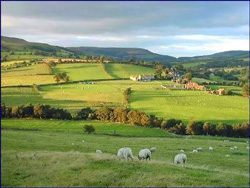Walks in the North York Moors
 On 28th November 2002, the North York Moors celebrated 50 years as one of Britain's eleven National Parks. Back in 1952 a report leading to its designation as a National Park said, "The North York Moors are selected on their intrinsic merits as an area of beautiful and unspoilt country and magnificent coast with a wealth of architectural interest. It contains, within a relatively small compass, an amazing wealth and variety of beauty."
On 28th November 2002, the North York Moors celebrated 50 years as one of Britain's eleven National Parks. Back in 1952 a report leading to its designation as a National Park said, "The North York Moors are selected on their intrinsic merits as an area of beautiful and unspoilt country and magnificent coast with a wealth of architectural interest. It contains, within a relatively small compass, an amazing wealth and variety of beauty."
England's largest expanse of heather-covered moorland is to be found in the North York Moors and in late summer (August/September) a magnificent mass of purple blooms can be seen for miles around. Old crosses and mysterious standing stones are dotted around the area, often to be found beside ancient moorland tracks which criss-cross over the high, exposed ridges. Tumuli, howes and barrows, the burial grounds of early man dating as far back as the Bronze Age, are to be seen all over the moors.
The North York Moors also contain some magnificent ruins - the abbeys at Rievaulx and Whitby and the castles at Pickering and Helmsley, to name but a few, not forgetting the ancient Roman Road across Wheeldale Moor - all of them depicting even more evidence of the different cultures of people who settled in the area over many hundreds of years.
But the North York Moors doesn't just consist of areas of wild moorland. Its eastern fringe boasts a dramatic coastline with some of England's highest and finest cliffs. Much of the coastline remains unspoilt, with access to the shore being limited in many parts to small fishing villages such as at Staithes, Runswick and Robin Hood's Bay. Just outside the National Park boundaries lie the larger fishing ports of Whitby and Scarborough - these are very popular places for tourists all year round.
About half of the North York Moors are forested. However, this does not detract from the area's natural beauty - in fact, it compliments it. Some of the largest forests, Dalby, Cropton and Langdale, attract thousands of visitors, many of them walkers who can explore the miles and miles of forestry tracks, sharing the wonderful natural habitat enjoyed by so much local wildlife.
 The open moorland attracts a wide variety of birds such as golden plover, curlew, lapwing, snipe and, of course, the most common bird to be seen on the moors, the red grouse. In fact, it is because of the grouse that much of the North York Moors are maintained. Vast areas of heather can often be seen being burnt, under control, by estate workers. This is to encourage new growth, the young shoots being a favourite food of the grouse. On the 'Glorious 12th' (August) the grouse-shooting season begins - not all of us find it 'glorious' but, without the grouse shooting, much of the heather moorland would be left go 'wild' and, in doing so, would lose much of its charm.
The open moorland attracts a wide variety of birds such as golden plover, curlew, lapwing, snipe and, of course, the most common bird to be seen on the moors, the red grouse. In fact, it is because of the grouse that much of the North York Moors are maintained. Vast areas of heather can often be seen being burnt, under control, by estate workers. This is to encourage new growth, the young shoots being a favourite food of the grouse. On the 'Glorious 12th' (August) the grouse-shooting season begins - not all of us find it 'glorious' but, without the grouse shooting, much of the heather moorland would be left go 'wild' and, in doing so, would lose much of its charm.
There are also many beautiful and fertile dales to be found in the North York Moors - the fields often appear as 'patchwork quilts' of shades of green and yellow. Most are divided by ancient drystone walls, constructed over many generations by our forefathers. Most of these walls have withstood the batterings of years of winter storms, and most remain as strong and intact as the day they were built. Remote farms, many of them now ruinous, can be seen amongst the dales. Mostly sheep and cattle are reared as well as arable crops being grown.
In the dales villages, traditionally centred around a church, a school and an inn, visitors are always given a warm welcome by the locals. Many of the pubs retain their old characteristic charms of oak-beamed ceilings, open log fires and, of course, traditional ales!
To sum up, there is something for everyone in the North York Moors – and especially for walkers, there is no finer place to visit.
Don Burluraux
North York Moors CAM